How To Make Quark Cheese
This post may contain affiliate links. See my disclosure policy.
Quark is a wonderfully creamy, spreadable soft cheese that’s deliciously versatile in both sweet and savory dishes. Now you can make it yourself for a fraction of the cost and it tastes better than store-bought! Learn how to make homemade quark cheese the right way for the BEST flavor and texture!
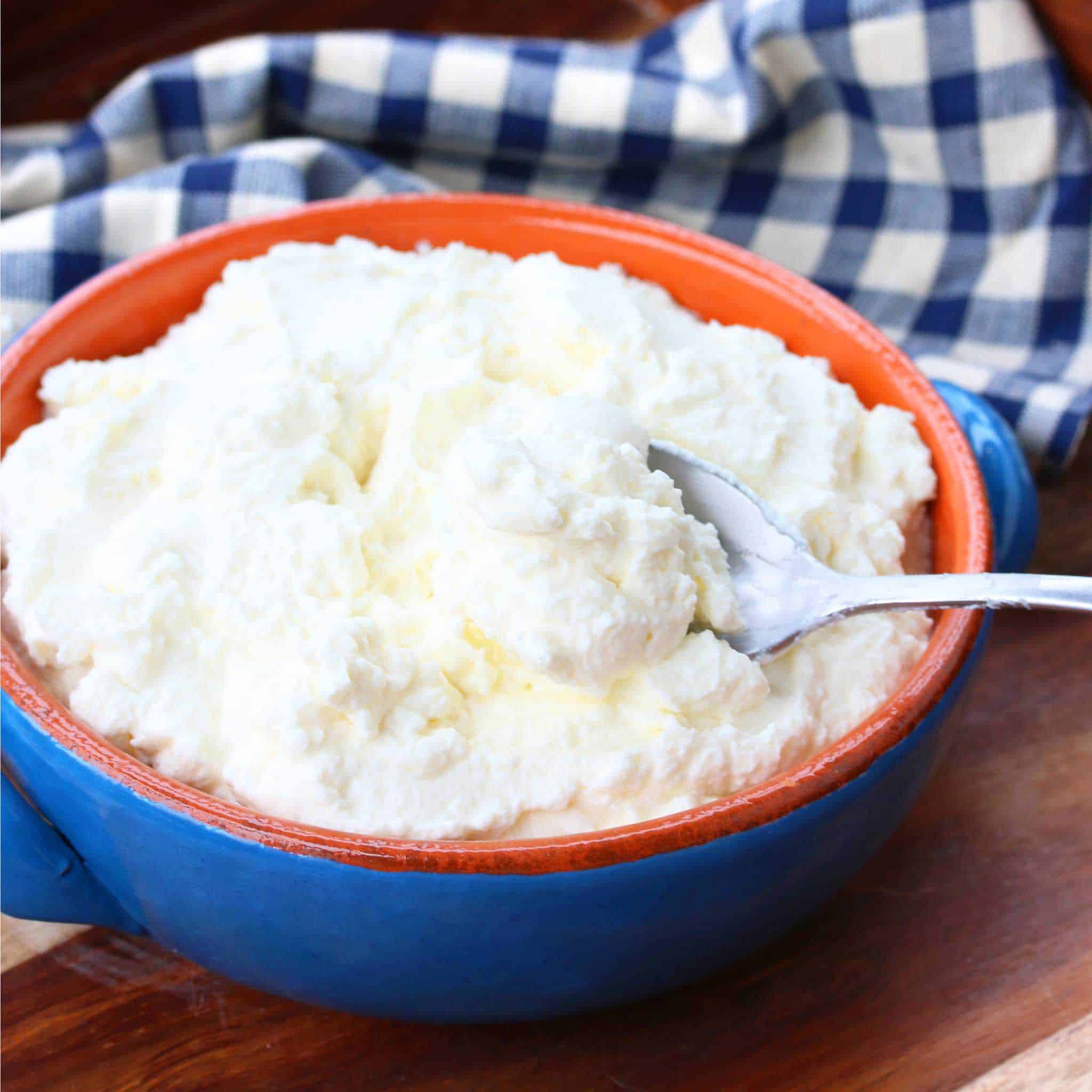
Being from southern Germany, Quark is something I grew up eating on a regular basis. Since moving to the U.S. I’ve had to adjust to the fact that I can no longer readily or cheaply find it in the grocery stores. For anyone living outside of Western Europe, quark is not only challenging to find (in some places downright impossible), it’s also very expensive. This tutorial will show you how to make quark right at home that not only tastes better than the store-bought stuff, but is also much cheaper!
What is Quark?
Quark is a kind of soft, creamy, spreadable cheese that has been around for millennia and is known by different names in different countries. The most popular version of this cheese is Germany’s Quark. It’s very versatile and is used in both sweet and savory recipes. Some have dubbed it as “Germany’s Greek yogurt” but it’s really not an accurate comparison because not only is it thicker (a spreadable cheese) and has a different flavor (less tart and tangy, mild but more complex), the process of making it is also different. It has also been described as something of a mix between yogurt and cottage cheese.
Is Quark Healthy?
Quark is a great source of protein, calcium, vitamins A and B, and probiotics. Quark is traditionally made with whole milk and so cup for cup has a higher protein content than plain, low-fat Greek yogurt or skyr. Being made with whole milk it has a higher fat (and therefore calorie) content than low-fat yogurt so keep that in mind if you’re on a calorie-restricted diet.
How to Use Quark
Quark is very versatile and, like cream cheese, cottage cheese and yogurt, is used in a lot of both sweet and savory recipes. Here are a few ideas to get you started:
- Spread it on toast or bagels with your favorite savory or sweet toppings
- Use it as a base for parfaits
- Mixed with fruit preserves or fresh fruit for a quick and healthy dessert
- In smoothies for a great velvety texture
- Use it in anything that calls for cream cheese
- On baked potatoes
- Add herbs and garlic to make a delicious spreadable cheese or serve with boiled potatoes
- Add lemon zest or cinnamon and honey for a delicious fruit spread or dip
- Filling Danish pastries
- In your muffin, cupcake or cake batter
- In bread doughs
- In creamy salad dressings
- In creamy sauces in place of sour cream, heavy cream or yogurt
German cheesecake is also made with quark. Many of our readers have lamented the fact that they can’t make proper German cheesecake because it’s so difficult to find quark and when you do it comes with a hefty price tag. Friends, problem solved!
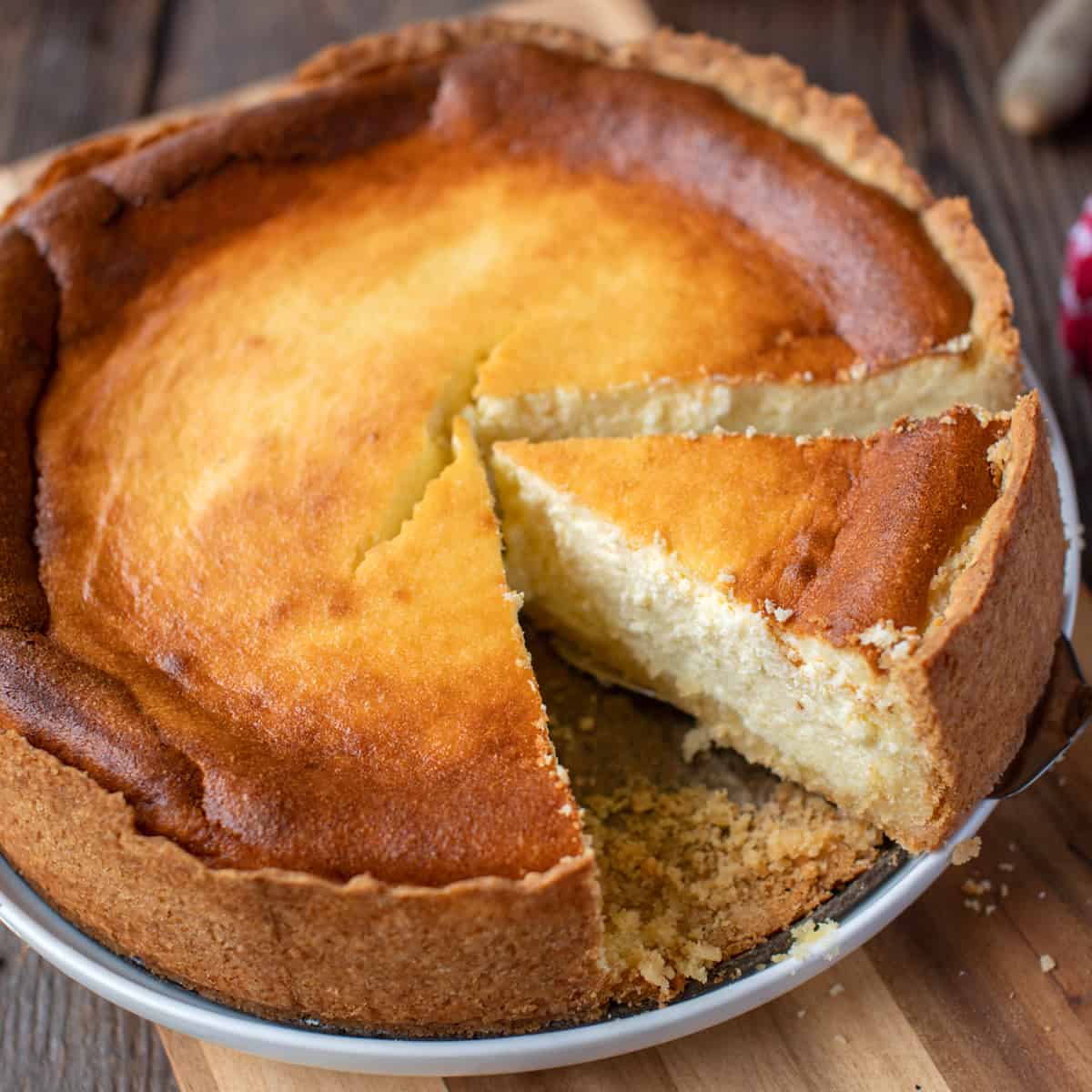
How Long Does Quark Keep?
Made as described in this recipe your quark will keep for about two weeks in the refrigerator.
Can You Freeze Quark?
You can but it isn’t idea as the texture and consistency will change. As it thaws the liquid will separate so give it several good stirs.
Should I Use Whole, 2%, Skim or Non-Fat Milk?
For the best texture and flavor we recommend using whole milk. But you can use 2% or skim milk if you prefer. We do not recommend using non-fat milk.
Hands down, raw milk will give you the best texture and flavor (that’s what I use). However, you can make great quark with pasteurized milk also. If you can find non-homogenized, even better. If not, proceed with what you have.
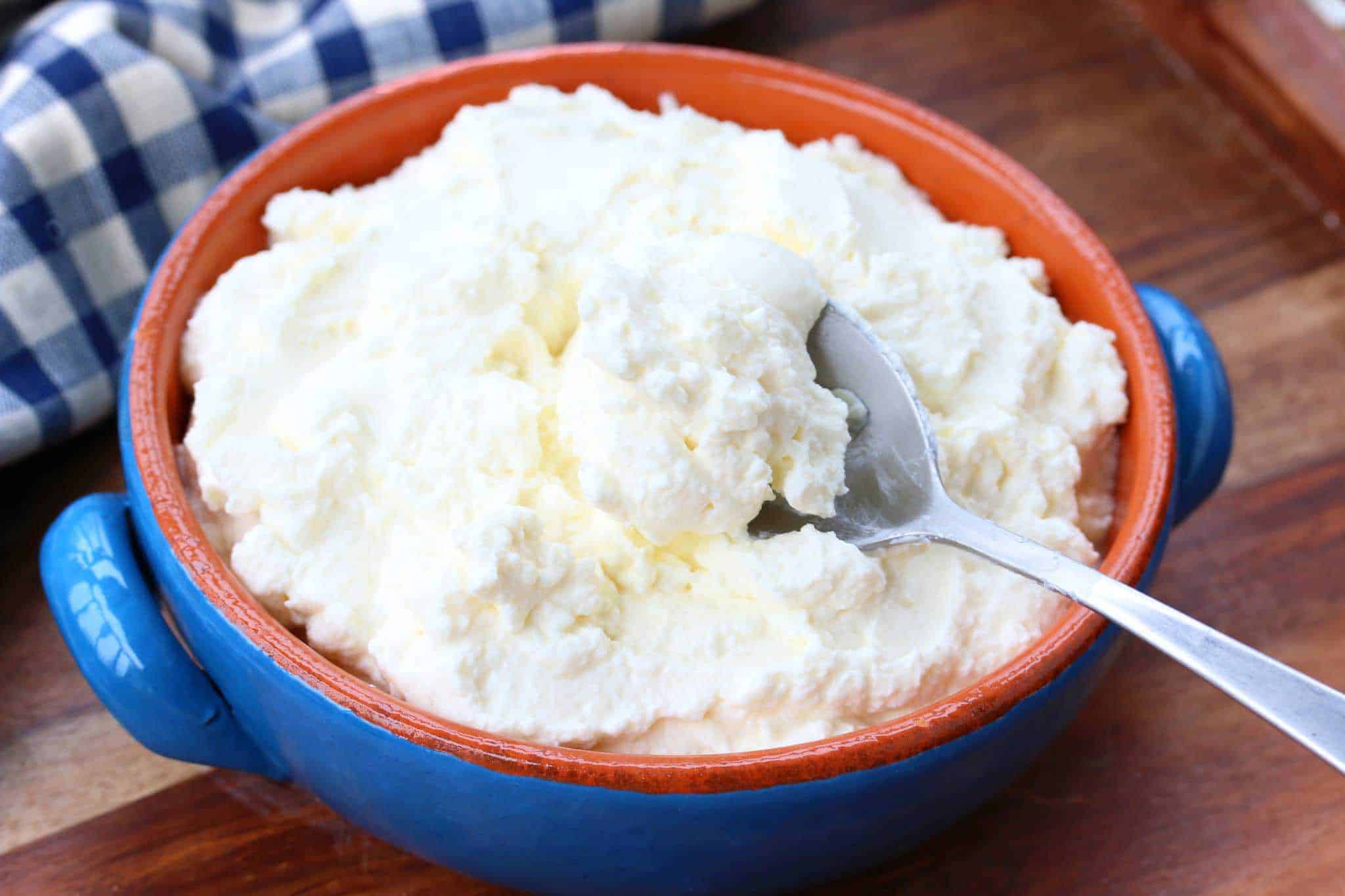
Do I Have To Use Rennet?
Traditionally quark was made without rennet. But that’s because traditionally quark was made with raw milk. Pasteurized milk will not “set” or thicken as well as raw milk and so a tiny bit of rennet is used.
If you’re vegetarian you can use vegetarian rennet, however some people report that it has a bitter flavor.
Do Have to Use a Culture or Can I Use Buttermilk?
Here’s the deal: The vast majority of recipes out there for quark call for heating milk, mixing in buttermilk, letting it sit for several hours until it thickens and then straining it.
The problem with using buttermilk to make quark:
Let’s start with a little background. Traditionally buttermilk was what was left behind after creamed was made into butter. The leftover liquid would be left to sit at room temperature for several days and undergo fermentation wherein milk sugars would be converted into lactic acid and bacteria/cultures would grow. The end result would be a mildly sour and slightly thickened buttermilk with healthy live cultures that could be consumed directly or used in a variety of cheesemaking processes.
The challenge today is that virtually all dairy products are pasteurized, including the buttermilk you get at the store. What this means is that all the benefits of the fermentation process are gone and that all the live cultures/bacteria have been killed off. And those live cultures in the buttermilk are the very reason many recipes call for it when making quark.
So to try and circumvent, manufacturers simply reintroduce bacteria to pasteurized low-fat milk and then market it as “cultured buttermilk.” The result in a completely inferior-tasting product (no wonder many people say they dislike buttermilk – and would likely change their minds if they could taste the “real thing”). This likewise results in an inferior-tasting quark. And how do manufacturers make up for the loss of the naturally-thickened texture of REAL buttermilk? They add salt and thickeners: Starch and/or carrageenan.
So for the best-tasting and best-texture quark, we highly recommend skipping the fake, inferior-tasting buttermilk and using a real culture to inoculate your quark. This particular culture is called mesophilic culture and is the culture that is found naturally in REAL, traditionally fermented buttermilk (more on that below).
In Short….
Using buttermilk is an “easy quark” method and while it will get you a thickened milk product that you can use as quark in a pinch, but it will lack the same thickness and creaminess and will not have nearly as good or complex a flavor. We highly recommend gathering up the ingredients you’ll need to make quark that has the best flavor and the best texture.
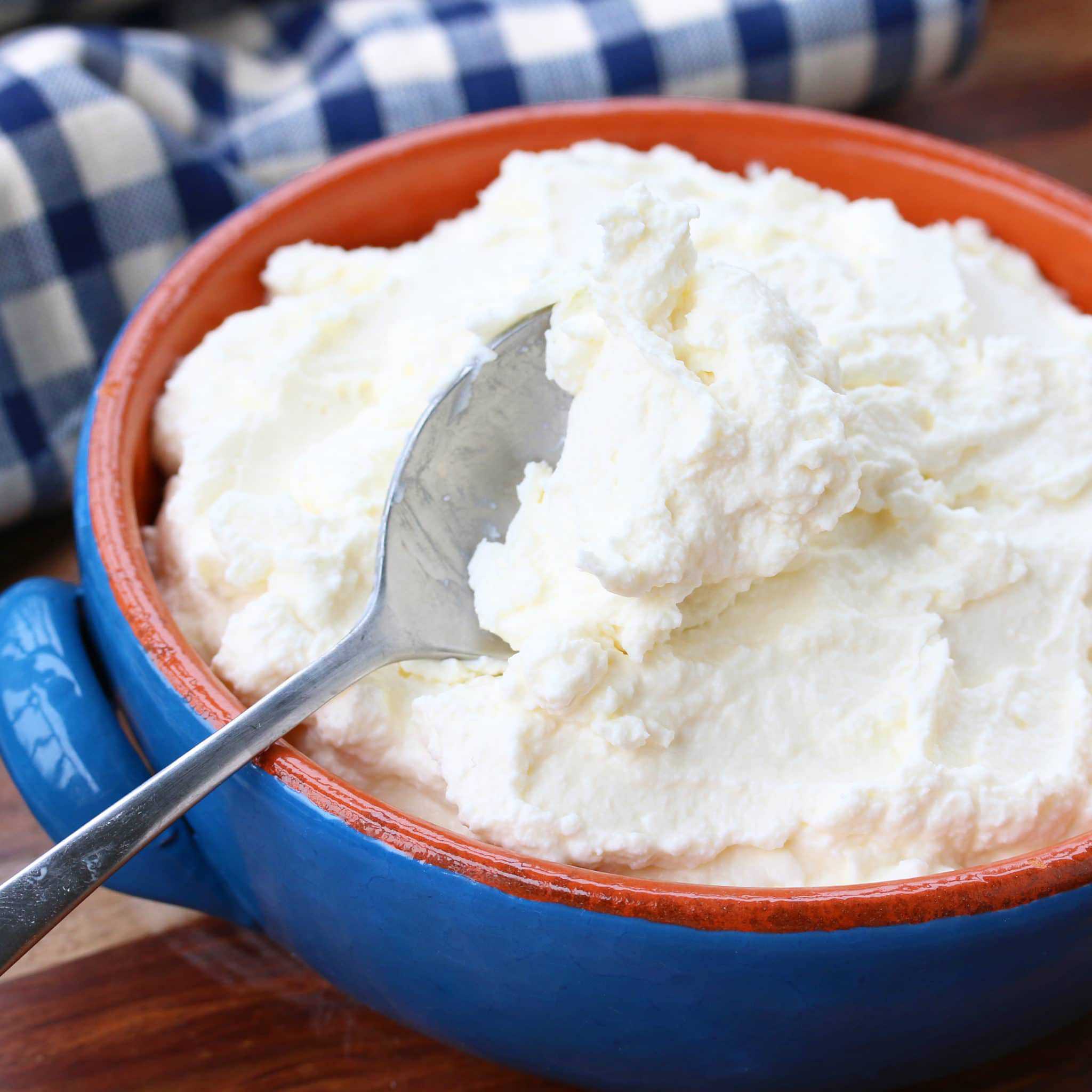
Quark Ingredients and Equipment
Here’s what you’ll need to make homemade Quark:
- A large stainless steel pot
- A stainless steel skimmer
- Whole Milk
- Mesophilic culture
- Calcium chloride
- Liquid rennet
- Thermometer
- Cheesecloth
If you’re into cheesemaking you’ll already have these items on hand. The pot and skimmer you can of course use forever and a good quality cheesecloth can be reused many times over. There’s enough calcium chloride and rennet in a bottle to make more quark than you’ll know what to do with. And the mesophilic culture will be measured out in 1/4 teaspoons per batch of quark and will make several batches. In other words, these items are good investments if you plan on making quark or other cheeses frequently. Let’s look at a few of these items in detail.
Stainless Steel Skimmer
You’ll use this to draw the culture and rennet into the milk. You can find skimmers in most kitchen stores or here on Amazon.

Mesophilic Culture
A standard cheese-making ingredient, this is the live bacteria that provides the flavor for you quark. You can find mesophilic culture in cheesemaking and winemaking speciality shops or here on Amazon.
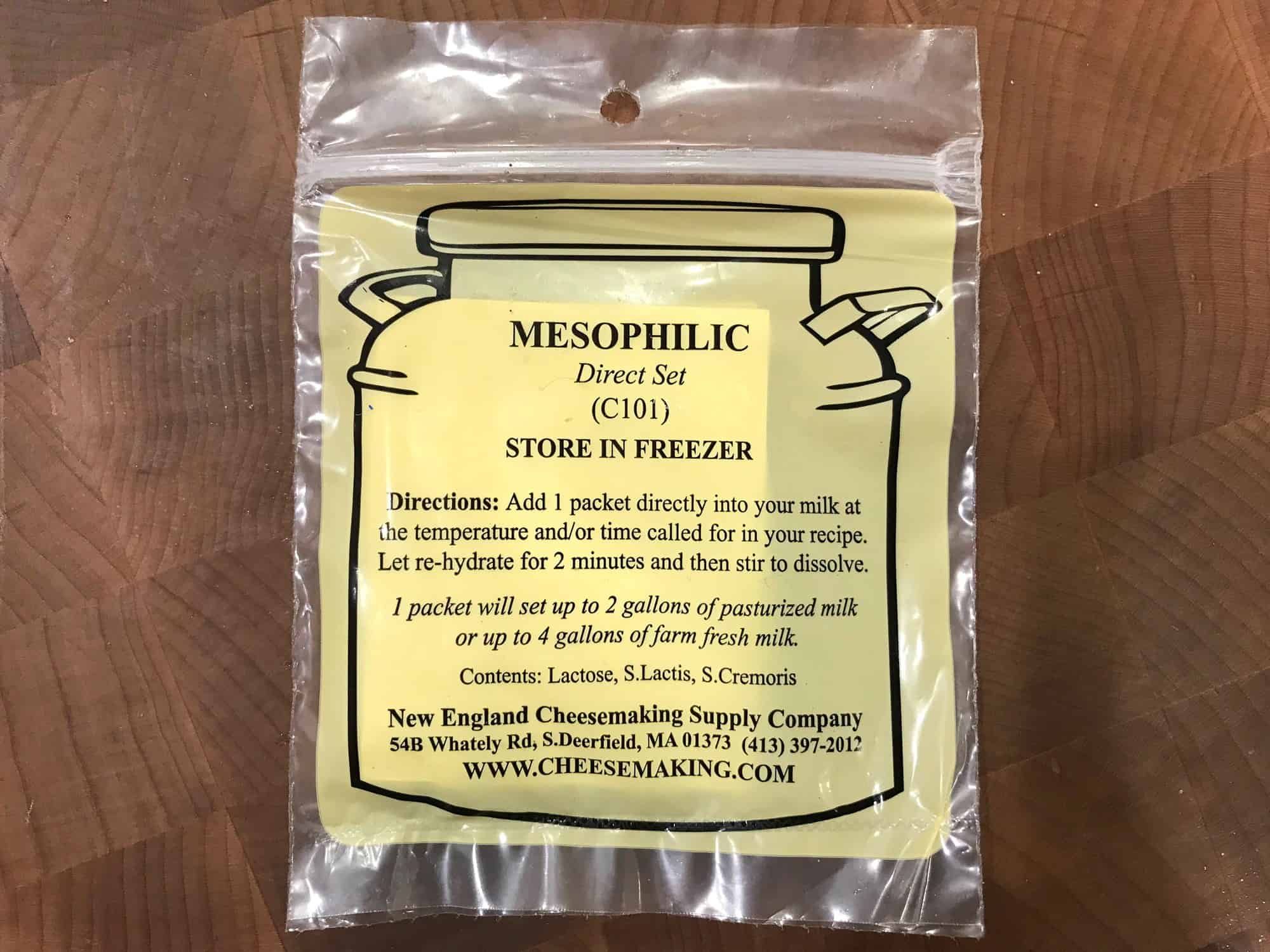
Calcium Chloride
A standard cheese-making ingredient when using store-bought pasteurized milk, it helps the milk coagulate and set more firmly. If using raw milk you can omit this. You can find calcium chloride in cheesemaking shops or here on Amazon.
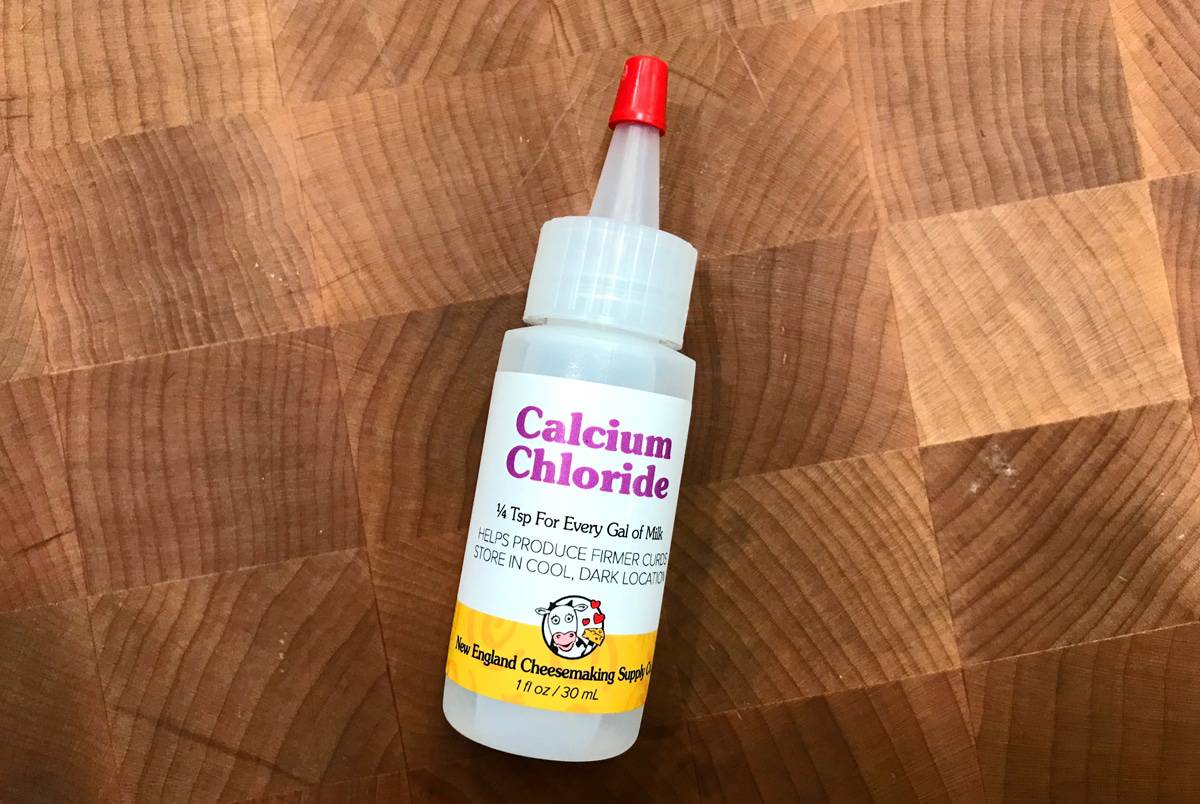
Rennet
A standard cheese-making ingredient, in conjunction with the calcium chloride this also helps coagulate and thicken your milk. You can find rennet in cheesemaking and winemaking specialty shops or here on Amazon.

Thermometer
You will need a thermometer to check the temperature of your milk. You can use a dairy thermometer or a regular digital thermometer. I use an instant read thermometer which I already have on hand and use regularly for bread-baking and other things.
Cheesecloth
This is what you will use to drain your thickened milk. I use and recommend this cheesecloth because it’s 100% unbleached cotton, is high grade, is very durable for multiple uses, and you get a ton of it. Overall it’s the best value I have found for the quality.
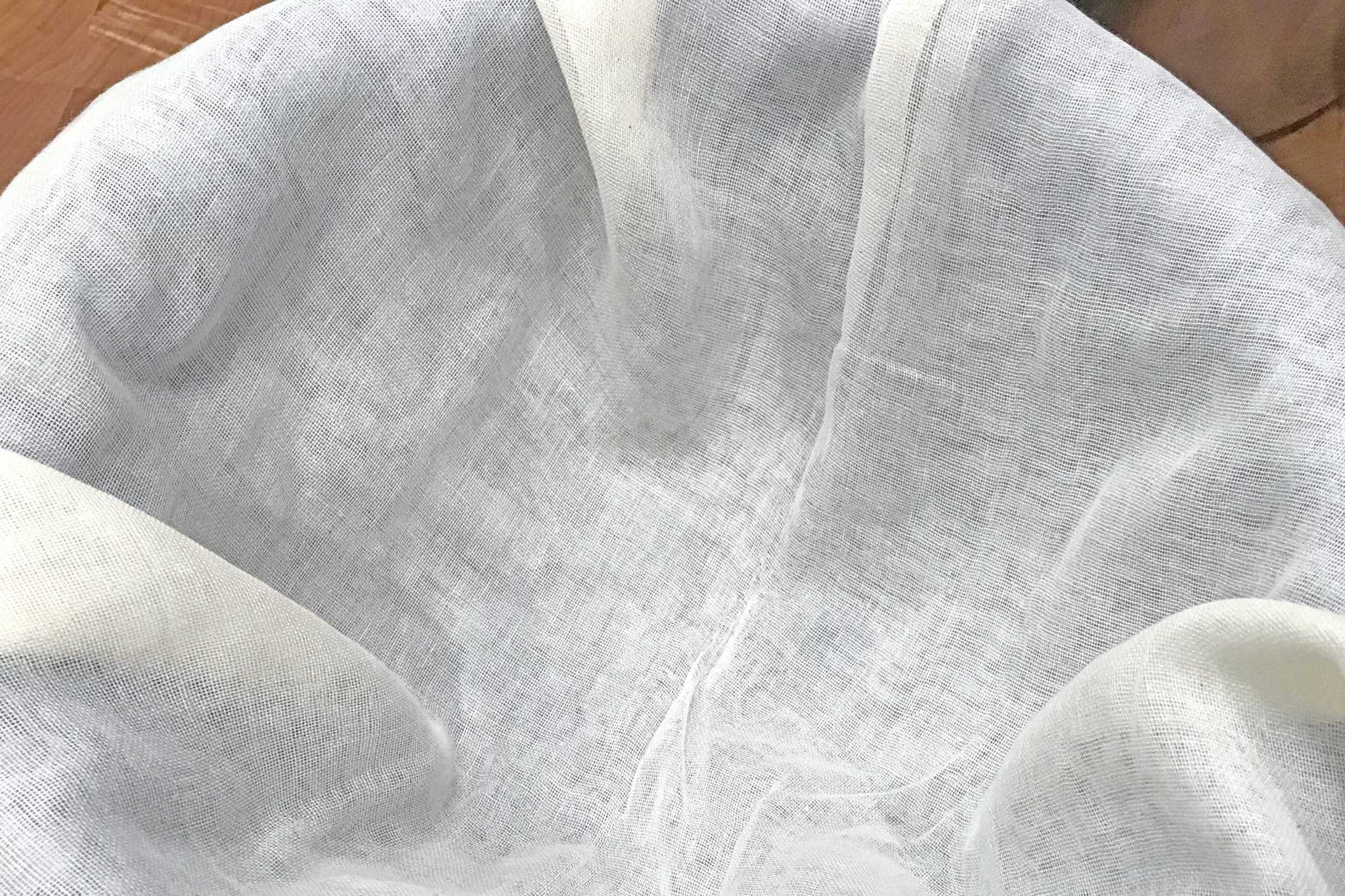
What to Do With Leftover Whey
Whey is the natural by-product whenever you’re making a cheese or yogurt product and the longer you strain the product the more whey you will get. Whey is milk minus the fats and solids, so basically water with lactose and protein. And it’s the protein that’s the valuable ingredient here. Milk contains two types of protein, casein and whey. Most of the casein ends up in the quark and the whey is in the liquid by-product.
How can you this leftover liquid whey? Here are a few ideas:
- Use it to make ricotta cheese
- Use it in place of water when you’re making broth or soup for an extra rich broth.
- Use it in place of water for baking bread or pastries.
- Add it to your smoothies of an extra protein boost.
- If you have a vegetable garden, use it lower the pH level of your soil if you’re growing things that prefer soil with a higher acidity level, like tomatoes.
Whey can be frozen and will keep in the freezer for up to 6 months.

How To Make Quark
Let’s make some homemade quark!
Put the milk in the sterilized pot over medium heat. Slowly heat it to 77 F. Don’t try and speed up this process or the milk will not set properly. Stir the milk gently with a sterilized stainless steel spoon to prevent scorching. Remove the pot from the heat.
Sprinkle the mesophilic culture evenly over the surface of the milk and let it sit for 5 minutes to rehydrate.
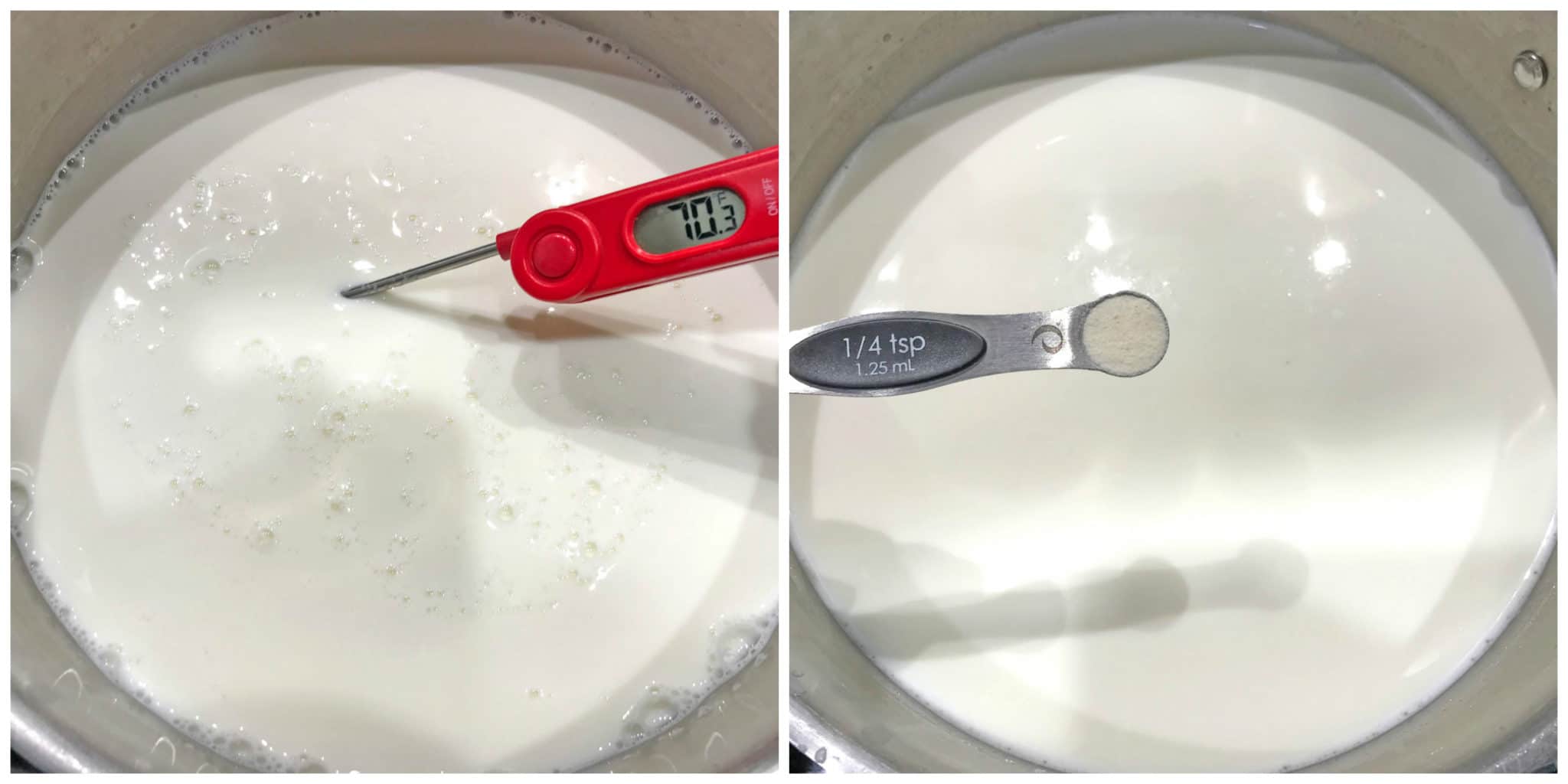
Use a sterilized stainless steel skimmer, moving it in a gentle up-and-down motion to draw down and mix in the culture, avoiding breaking the surface of the milk.
Dilute the rennet in 1/4 cup of cool, non-chlorinated water. Give the milk a gentle stir and while it’s swirling, add the diluted rennet to the milk. Immediately stir the milk with the skimmer using the same up-and-down motion. Do this for about 2 minutes, making sure the rennet is thoroughly mixed throughout the milk, otherwise the milk will not set properly.

Cover the pot and let it sit in a draft-free location at room temperature for 24 hours (wrap the pot in a large towel if needed).
After 24 hours check the milk. Tip the pot carefully to drain off the whey on the surface.
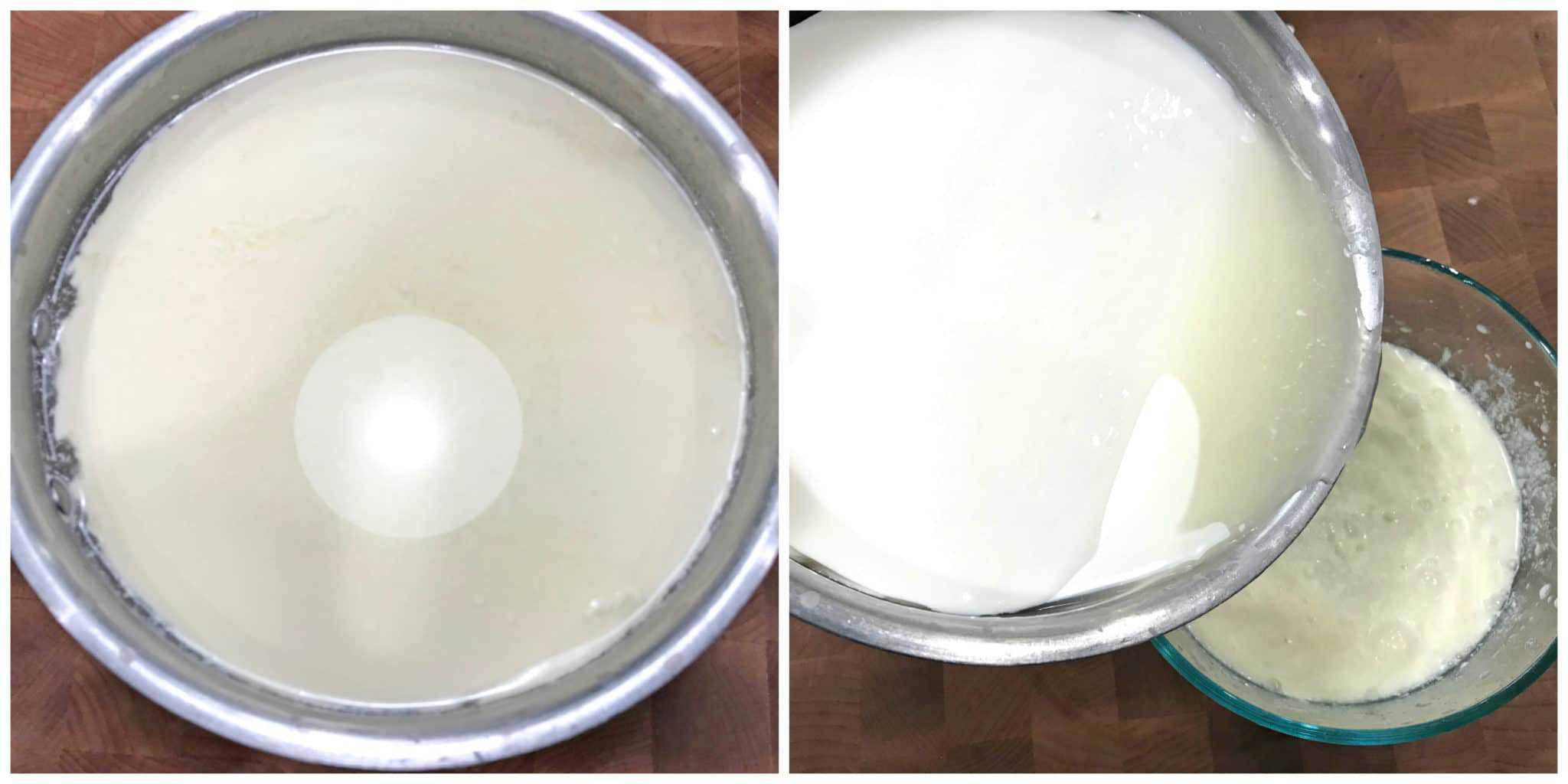
If the milk is properly set it will have pulled away from the sides.
Use a long, sterilized knife to check for a clean break in the thickened milk/curd (bottom right picture). If you can cut through it and get a clean break the milk is properly set. If it isn’t, let it continue to sit and check again after 30 minutes. Repeat if needed.

Use a long, sterilized knife to cut 2-inch-wide strips from top to bottom through the curd. Then follow the same process to cut 2-inch strips horizontally from side to side.

Now that you’ve used a long knife to cut the curd vertically, next use the skimmer to cut the curd horizontally into cubes as you scoop them out of the pot.
Place the curds in a colander lined with cheesecloth. Depending on the size of your colander you may need to work in batches. Let the curds drain for about 4 hours (it may be less depending on the mesh size of your cheesecloth).
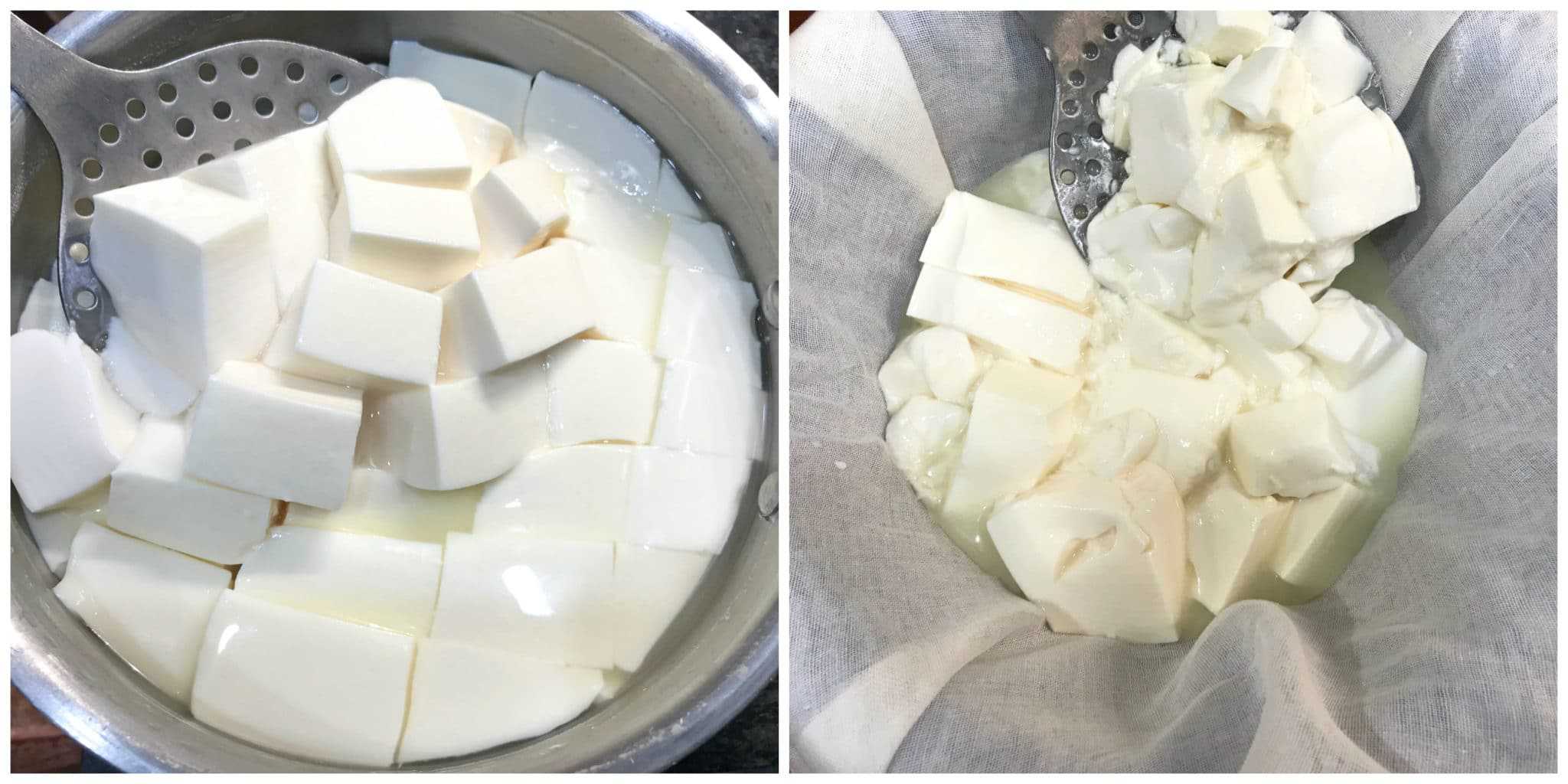
Let the curd drain until you get a thick, spreadable consistency. Transfer the finished quark to a bowl, give it several good stirs to break up any lumps, cover and refrigerate until ready to use. It will keep in the fridge for up to 2 weeks.

For an even creamier consistency you can make what the Germans call Sahnequark, or “cream quark”, by stirring in a little heavy cream.

Enjoy!

Be sure to also check out my tutorials on:
Save This Recipe
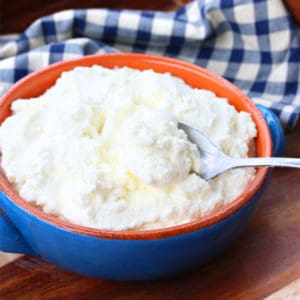
How To Make Quark Cheese
Ingredients
- 2 gallons whole milk (or half whole/half 2%) (whole milk will produce the creamiest, most flavorful result. Raw milk, which is what I use, will produce the very best results.)
- 1/4 teaspoon mesophilic culture
- 1/2 teaspoon liquid calcium chloride (omit if using raw milk)
- 1/2 teaspoon liquid rennet
- Additional equipment needed:
- stainless steel skimmer
- cheesecloth
- thermometer (you can use a dairy thermometer or a regular instant read digital thermometer)
Instructions
- Put the milk in a large sterilized pot over medium heat. Slowly heat it to 77 F. Don't try and speed up this process or the milk will not set properly. Stir the milk gently with a sterilized stainless steel spoon to prevent scorching. Remove the pot from the heat.
- Sprinkle the mesophilic culture evenly over the surface of the milk and let it sit for 5 minutes to rehydrate. Use a sterilized stainless steel skimmer, moving it in a gentle up-and-down motion to draw down and mix in the culture, avoiding breaking the surface of the milk. Stir the calcium chloride in 1/2 cup of cool, non-chlorinated water. Give the milk a gentle stir and while it's swirling, add the diluted calcium chloride to the milk. Immediately stir the milk with the skimmer using the same up-and-down motion. Stir the rennet in 1/2 cup of cool, non-chlorinated water and repeat the process of using the skimmer with the up-and-down motion. Make sure the calcium chloride and rennet are thoroughly mixed throughout the milk, otherwise the milk will not set properly.Cover the pot and let it sit in a draft-free location at room temperature for 24 hours (wrap the pot in a large towel if needed).After 24 hours check the milk. Tip the pot carefully to drain off the whey on the surface.
- If the milk is properly set it will have pulled away from the sides. Use a long, sterilized knife to check for a clean break in the thickened milk (see pics in blog post). If you can cut through it and get a clean break the milk is properly set. If it isn't, let it continue to sit and check again after 30 minutes. Repeat if needed. Use a long, sterilized knife to cut 2-inch-wide strips from top to bottom through the curd. Then follow the same process to cut 2-inch strips horizontally from side to side. Now that you've used a long knife to cut the curd vertically, next use the skimmer to cut the curd horizontally into cubes.
- Place the curds in a colander lined with cheesecloth. Depending on the size of your colander you may need to work in batches. Let the curds drain for about 4 hours (it may be less depending on the mesh size of your cheesecloth). Let the curds drain until you get a thick, spreadable consistency. Transfer the finished quark to a bowl, give it several good stirs to break up any lumps, cover and refrigerate until ready to use. It will keep in the fridge for up to 2 weeks. Yield: This will vary according to what type of milk you use and how long you let it drain. Yield will be approximately 4 pounds.
- For an even creamier consistency you can make what the Germans call Sahnequark, or "cream quark", by stirring in a little heavy cream.
Originally published on The Daring Gourmet February 2, 2020



















I have missed German quark for too long! Finally I can make my own. So good! Mixed some fresh herbs in it, little bit of lemon juice, salt and pepper and delicious!
One question: the quantities in your recipe are just too much for me as I don’t make cheesecake we just eat the quark on our fresh sourdough bread.
Could you share this recipe with us for a smaller quantity like 1/2 gallon of milk and not 2 gallons?
That would be great!
Thanks again for this recipe!
Wonderful! I’m so glad you enjoyed it, Ulla, thank you! In the world of cheesemaking it gets tricky working with small quantities and for some reason often just doesn’t turn out right. I think reducing the recipe by half should be fine though – so using 1 gallon and cutting all the other ingredients in half as well. Worth mentioning too is that you can freeze Quark for a few months. It will slightly alter the texture but it’s still decent. Just thaw it slowly in the fridge.
Hi, I have a whole goat milk kefir with 11 live active cultures(from a very good manufacturer) which is Pasteurized but not UHT. I’ve read it’s considered a mesophilic culture, how much of it should I use to replace or rather substitute 1/4 tsp culture(as in your recipe)?
Also, I only have 1.5 gallons of milk. Can I adjust the recipe?
Hi Alex, I haven’t tried this with goat milk so I’m really not sure if or how effectively it would work as a substitution.
Hello, since I’m living out in the boonies, no access to big city luxuries like rennet or calcium chloride or mesophilic bacteria cultures, I wonder if I could use a couple spoonful of Greek yogurt instead? And ACV and kosher salt?
Hi Sanni, I’m afraid those substitutions won’t enable the Quark to achieve the right consistency or that authentic Quark flavor. Those ingredients can all be ordered online though, I provide links in the recipe and blog post. Alternatively, you can find some recipes online for homemade Quark that don’t use those ingredients, but it’s not actually Quark at all, it’s really just homemade yogurt, but in a pinch you can use that as a substitute. If you’d like to go that route, I also have a recipe for homemade yogurt and you can strain it until it’s very thick Greek yogurt which you can use in place of Quark in recipes that call for it: https://www.daringgourmet.com/easy-homemade-greek-yogurt/
Do you have a video to share of mixing with the skimmer and not breaking the skin?
Hi Corise, I don’t but it’s the same process as for making most cheeses and there are countless ones on YouTube.
Hi Kimberly,
I just made this quark recipe (actually half portion with 4.5 L milk and giving 1,470 g of quark) and it turned out wonderfully! I am so happy with the result. I could never find a satisfactory version of quark in the shops (even in a city as big as Toronto) that was close to the version I remember from my childhood, but this result met the bar. Thank you so much for sharing it, and especially the attention to detail in the recipe – nice job! In fact, all your recipes are so well written and presented!!!
“Bis bald” and cheers!
Ah that’s fantastic, Arne, thank you so much for the positive feedback, I’m thrilled that the Quark was a success! And thank you very much for your kind words and compliment <3 For the benefit of our other readers, could you please share whether you used raw milk or store-bought/pasteurized milk? And did you use both the rennet and the calcium chloride?
I used 2% store-bought, pasturized milk, and used both the calcium chloride and rennet. The only thing I would change next time is letting it drain a bit longer to make it a bit thicker – and maybe try the creamier version called “Sahnequark”/”cream quark” that you mentioned in your notes.
Today I used a portion of the quark (500 g) to make a German-style cheesecake, for our afternoon coffees this weekend. I’ll serve raspberry sauce (from our garden berries last summer) with it. I’m so looking forward to it. Thanks again!
Awesome, thank you so much for those additional details, Arne! Happy eating! <3
I would like to use raw milk. Can the rennet be optional too in this case?
Hi Mari, technically yes but I still use it to ensure a solid set in the curds. Depending on the breed of cow, the profile of the milk can vary. You can try a smaller batch without rennet and see how it goes.
Hello Kimberly,
Thank you so much for this! I am exactly in this situation where I would like to make a proper German cheesecake but can’t find Quark anywhere. You are using 2 gallons of whole milk, how much Quark does it yield?
Hi Diana, 2 gallons of milk will yield roughly 4 pounds, or 1800 grams, of finished Quark.
This looks interesting and I’d like to give it a try, but have a question about your instructions for adding the calcium chloride and rennet. You say to give the milk a gentle stir and while it’s swirling, add the diluted calcium chloride to the milk, then use the skimmer in an up-and-down motion. (Similarly for the rennet.) In this process, do you need to avoid breaking the skin that’s formed on top of the milk? How does one do that and ensure that everything is mixed thoroughly?
Hi Sara, yes you should avoid breaking the surface of the milk. Keep the gentle up and down motion going while keeping the skimmer beneath the surface of the milk. Do that for about 2 minutes. This will enable the calcium chloride and rennet to fully distribute throughout the milk.